![]()
![]()
![]()
Use LEFT and RIGHT arrow keys to navigate between flashcards;
Use UP and DOWN arrow keys to flip the card;
H to show hint;
A reads text to speech;
22 Cards in this Set
- Front
- Back

|
Necropolis, Cerveteri
Orientalizing/Archaic ~ 600 bce • Tombs occupy west side of river, where sun sets, like Egypt • Group of rounded mounds with several streets with mastaba-like houses |
|
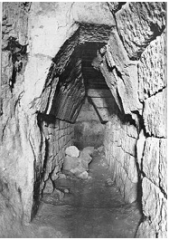
|
interior corridor
end of 7th/ early 6th century bce Archaic • Use of corbel vault as used by Myceneans |
|
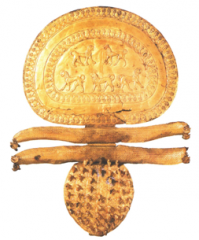
|
fibula (Regolini-Galasi Tomb, Cerveteri)
amber, gold 670-650 bce Orientalizing • fine goldwork |
|
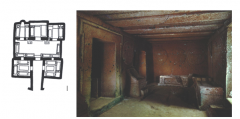
|
Tomb of the Shields & Chairs (interior)
Cerveteri 550-500 bce Archaic • domestic interior, resembles somewhat of a house: has doorways, doorframe, stone-cut rafters & couches, decorations, etc |
|
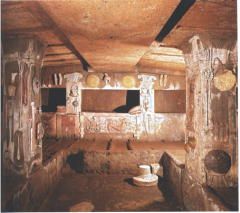
|
Tomb of the Reliefs
Cerveteri 3rd century bce Hellenistic • funeral couches/ shelves intended for the bodies • shields/ weapons needed for the afterlife • pictures of grave good, like Egypt |
|
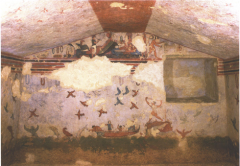
|
Tomb of Hunting and Fishing
Tarquinia fresco 520 bce Archaic • shows a natural scene, not meant to be an allegory • banquet above and nature scene below, images of afterlife, idyllic |
|
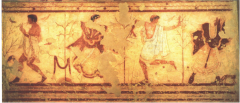
|
Tomb of Triclinium
Tarquinia 470-460 bce Classical • very famous, energetic • shows their reputation as a carefree people like the Minoans, not obsessed with military |
|
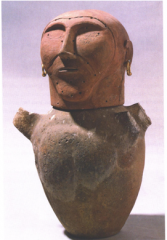
|
Cinerary Urn from Chiusi
terracotta 675-650 bce Orientalizing • isolated portrait heads, separated form body • Egyptians also used for of head urn • meant to hold ashes |
|
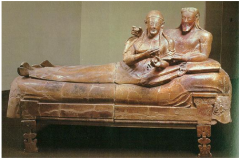
|
Sarcophagus of Husband and Wife, from Chiusi
ceramic 520 bce Archaic • were once holding drinking vessels |
|
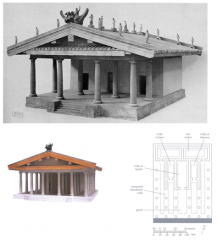
|
restored plan of Temple of Jupiter Optimus Maximus
Capitoline Hill, Rome 509 bce Archaic • deep porch with triple cella • dedicated to Jupiter, Juno, Minerva • accessible in only 1 direction, unlike a Greek temple • Italic type, not Greek |
|
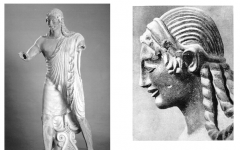
|
Apollo from Veii
510 bce Archaic terracotta • Resembles Greek Archaic style, especially with Archaic smile, but would never be confused as Greek • Resembles Etruscan energy rather than Roman, he is hurried and purposeful, not in arrested motion |
|
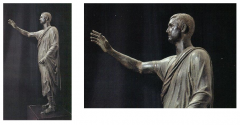
|
The Orator
1st century bce Hellenistic bronze • great masterpiece of late Etruscan, early Roman ("Romanized Etruscan") • veristic portrait, not idealized but has individual features • individual likeness & verism as oppsoed to stylized portraiture appeared later in Etruscan art • Romans were concerned with someone's social class/role rather than the natural & idealized man/woman like the Greeks • toga- sign of social rank, not a practical garment • elaborate shoes- sign of social rank • shows gravitas • Etruscans were skilled metalworkers, they achieved much of their wealth through exploitation of copper, iron & silver |
|

|
She-Wolf
500 bce Archaic bronze • spiritual mother of Rome because she nused babies Remus & Romulus, Romulus founded Rome • Medieval work • Has Archaic, stiff characteristics to it |
|
|
tumuli
|
monumental earth mound, often raised over a tomb. Where Etruscans buried their dead in chambers or placed their ashes in cinerary urns. Were grouped together outside the living spaces in a necropolis
|
|
|
dromos
|
pathway found in Etruscan tomb structures
|
|
|
gable
|
The triangular area framed by the cornice of a building and the sloping sides of a pitched roof. Often decorated with illustrations of animals and banquets in Etruscan burial chambers
|
|
|
palette
|
The range of colors used by a particular painter/culture. Etruscan palette changed considerably from bright reds and yellows to more somber darker colors, probably reflecting difficult times, when Romans were invading
|
|
|
alabsatron
|
perfume container
|
|
|
voussoirs
|
wedge-shaped piece of stone used in arch construction
|
|
|
pise
|
construction material consisting of packed earth, used by Etruscans for the building of living quarters. Few homes survive because they've fallen apart
|
|
|
atrium houses
|
When numerous rooms frame a large central courtyard, Roman technique used by the Etruscans for large villas/ palaces
|
|
|
exedra
|
alcove, often semicircular and framed with columns, often held sculptures
|

